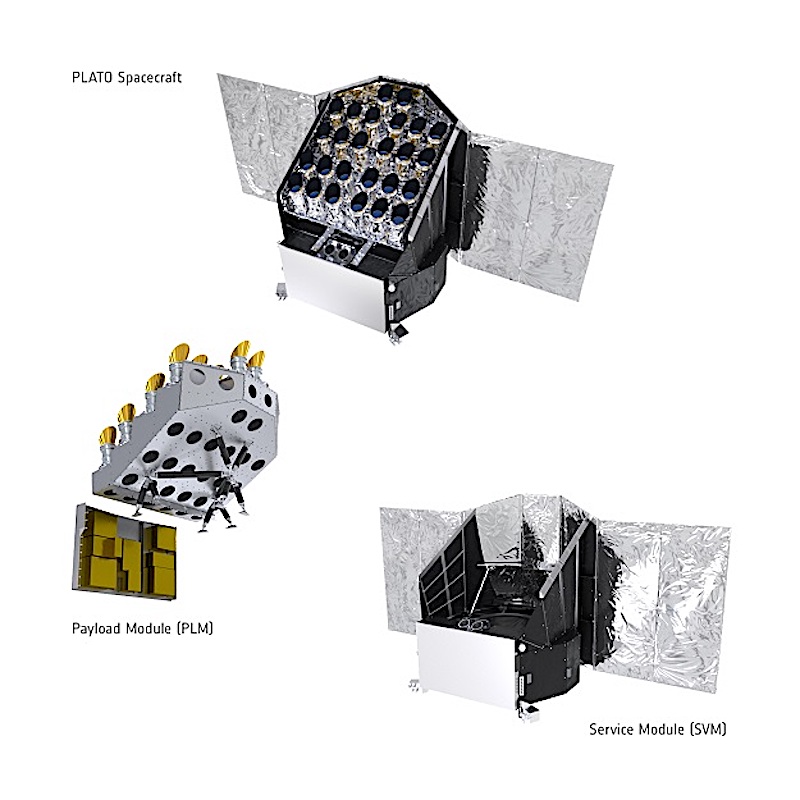
An artist’s impression of the European Space Agency’s Plato spacecraft. – ESA/ATG Medialab
Europe’s next big space mission – a telescope to hunt for rocky Earth-like planets outside our solar system – is due to launch in late 2026.
PLATO, or Planetary Transits and Oscillations of the Stars, is designed to find nearby possible worlds around Sun-like stars that we can explore in detail.
The space telescope will blast into orbit on Europe’s new rocket Ariane-6, which made its first flight last week after being developed at a cost of 4 billion euros (£3.4 billion).
Dr David Brown, from the University of Warwick, will give an update on the work at the Royal Astronomical Society’s National Astronomy Meeting at the University of Hull this week.
„Plato’s goal was to search for exoplanets around Sun-like stars and with orbital periods long enough to be in the habitable zone,” he said.
„One of the main mission objectives is to find another Earth-Sun parallel pair, but it is designed to carefully and precisely characterize the exoplanets it finds (ie their masses, radii and bulk density).”
However, Plato is not just an exoplanet hunter. It’s also a stellar science mission.
In addition to searching for exoplanets, it will study stars using a number of techniques, including asteroseismology (the measurement of the vibrations and oscillations of stars) to determine their masses, radii and ages.
Unlike most space telescopes, PLATO has several cameras – including one named after the famous astronomer and physicist Arthur Eddington, who won the Royal Astronomical Society’s prestigious gold medal in 1924.
Picture

Ten of the final cameras have been built and tested, the first of which was mounted on an optical bench – the surface that holds all the cameras in the right orientation – earlier this year. Credit OHP System AG
It has 24 'Normal’ cameras (N-CAMs) and 2 'Fast’ cameras (F-CAMs). N-CAMs are arranged in four groups of six cameras, with the cameras in each group pointing in the same direction, but the groups are slightly offset.
This gives Plato a much larger field of view, improved science performance, redundancy against failures and a built-in way to identify 'false positive’ signals that may reflect an exoplanet transit, Dr Brown explained.
„The planned observing strategy is to observe two patches of sky, one in the north and one in the south, for two years each,” he added.
„The southern part of the sky has been chosen, while the northern link won’t be confirmed for a few more years.”

The Plato spacecraft is a 3-axis stabilized system with a launch mass of 2500 kg including consumables, a structure measuring 3.5 m (x) × 3.6 m (y) × 3.7 m (z) and a deployed wingspan of approximately 9 m. It is designed to meet the specific requirements of the main mission: accommodate a large payload of 26 cameras and protect it from exposure to the Sun operate at the second Lagrange point L2 for up to 8.5 years (nominal mission duration 4.5 years); Provide a stable pointer for long-term observations; transmit large amounts of scientific data to Earth; To achieve this, the spacecraft consists of two main modules: the payload module and the service module. Several components of the spacecraft have completed their production programs and are nearing completion of their calibration tests. This includes the UK supply of front-end electronics (FEE) for N-CAMs. – ESA

The payload module, which houses the cameras, is mechanically decoupled from the rest of the spacecraft by a truss system with flexible joints (which ensure the quasi-isostatic support required to maintain the required pointing). The block is mostly made of carbon fiber to increase stiffness and reduce thermo-elastic deformations. It consists of a radiator panel (made of aluminium) in which all the payload electronic units are accommodated. – ESA
The service module contains all the systems required to operate the spacecraft in the designated orbit. This includes:
- a sun shield to protect the cameras from sunlight, and it carries the solar panels (three panels mounted on the spacecraft’s body and four deployable panels on the two wings) needed to provide power (3000 W) to the satellite;
- the propulsion system required to achieve and maintain orbit (a blow-down, monopropellant system);
- Attitude control system based on reaction wheels, thrusters, gyros, sun sensors and star trackers
- A communication system in X-band (for satellite control) and K-band (for scientific data transmission at high data rates, up to 72 Mbps), fixed high-gain antenna and three low-gain antennas (two of them fixed and one directional);
- A thermal control system based on heaters, radiators and multilayer insulation (MLI) to provide the required temperature for all units;
- A control and data management system to oversee the operation of the satellite, receive commands and control all autonomous functions, including handling possible conflicts.
All the electronic units are housed in the bottom panel which acts as a radiator. Based on a carbon fiber central tube and shear panels, the structure provides an interface for the launcher and a rigid platform for the payload module.
Built by University College London’s Mullard Space Science Laboratory, these operate cameras, digitize images and convert them for internal data processing.
Ten of the final cameras have been built and tested, the first of which was mounted on an optical bench – the surface that holds all the cameras in the right orientation – earlier this year.
The work is scheduled to start in December 2026.
astronomy, astronomy,

„Oddany rozwiązywacz problemów. Przyjazny hipsterom praktykant bekonu. Miłośnik kawy. Nieuleczalny introwertyk. Student.
